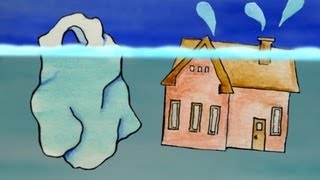(单词翻译:单击)
Have you ever heard the term, "tip of the iceberg"?
你们有没有听说过这个成语,“冰山一角”?
You know that icebergs are mostly underwater, their immense bulk hidden beneath the water. But why is that so?
你知道,冰山大部分都在水下,它巨大的体积都隐藏在水平面下。但是为什么呢?
Well, the density of pure ice is less than that of sea water.
因为纯冰的密度小于海水的密度。
Usually only 1/9 of the volume of an iceberg is above the water.
通常的冰山只有九分之一的体积是露出水面的。
The shape of the underwater portion is difficult to discern by looking at the above-surface portion.
水下那一部分的形状很难通过观察水平面上的冰山辨别。
This has led to the expression, "tip of the iceberg."
这演变成了一个成语:“冰山一角”。
Here are some thing you might not know about the icy islands.
你们可能对冰山不是那么地了解。
The life of an iceberg begins many thousands of years before it reaches the ocean.
一个冰山的形成发生在几千年前,在它达到海洋之前。
Unlike sea ice or pack ice, which form when the ocean freezes, glaciers are made of fresh water.
与海冰和浮冰不同的是,它们不是在海洋冻结的时候形成的,冰川里面是淡水。
For thousands of years, these glaciers build layer upon layer of ice,
千百年来,这些冰川建立在一层层的冰上面,
constantly compressing, moving, adding snow, compressing, and moving again as they inch along like a frozen river.
不停地压缩,移动,添加雪,压缩,再次移动,慢慢地像一条冰冻的河一样移动。
It is the force of gravity that pulls them towards the sea,
在重力的作用下,它们缓缓移向海洋,
where a glacier may calve off to become an iceberg or continue to spread up as an ice shelf or an ice tongue.
然后冰川可能会崩解,变成了冰山,或者继续积聚一层层的冰变成冰架或者冰舌。
Once an iceberg breaks away from the glacier or ice shelf, it will usually live for three to six years,
当一个冰山脱离了冰川或者冰架的时候,它通常会3到6年保持不变,
floating around, carried by the currents and tidal movements of the ocean.
到处浮动,随着水流和海洋的浪潮漂移。
As it floats along, it is battered by waves, melts, and smashes into land and sometimes other icebergs.
在它漂移的过程中,它被浪花击打,融化,撞到陆地,有时和别的冰山撞击。
Some icebergs are so unstable that they have more dramatic ends, heaving up, collapsing, and sometimes even exploding.
有些冰山尤其不稳定,它们的结局更具有戏剧性。升起来,倒塌,有时甚至爆炸。
And as they fall apart, many icebergs make all sorts of strange sounds.
而当它们分崩离析时,许多冰山还会制造各种奇怪的声音。
When a piece of iceberg melts, it makes a fizzing sound, called Bergie Seltzer.
当一块冰山融化时,它会发出嘶嘶声,这被称作“Bergie Seltzer”。
This sound is made when the water-ice interface reaches compressed air bubbles trapped in the ice.
这种声音来自水与冰的界面碰到被压缩、困在冰里的气泡。
As this happens, each bubble bursts, making a popping sound.
这种情况发生时,每个气泡破掉,发生啪啪的声音。
There are six official size classifications for icebergs. The smallest icebergs are called growlers.
冰山有六种正式的大小分类。最小的冰山称为残碎冰山。
They can be up the size of your car and are very dangerous for ships and boats
它们可以是你的车子大小,对于大船小船都非常危险
because usually they sit just at the waterline where they are not easy to spot.
因为它们通常就在吃水线的高度,不容易被发现。

Next are the bergy bits -- yes, that is their scientific name -- which can be up to the size of your home.
下一个是冰山块--是的,这就是它们的学名--大小和你的房子差不多。
The other four sizes are small, medium, large, and very large.
其他四种尺寸则为小、中、大及特大。
So just how big is a very large iceberg?
所以到底特大的冰山有多大呢?
Officially, any iceberg looming larger than 270 feet high above sea level and 670 feet long is considered very large.
准确地来说,任何在海平面以上部分达到270英尺高,670英尺长的冰山都是超级大的。
That's 27 stories of looming, blue ice.
那就是27层楼高的若隐若现的蓝色的冰。
And how do icebergs get that blue color anyways?
那到底冰山是怎么变成蓝色的呢?
When snow on the glacier is compressed over many hundreds of years,
当冰川上的雪通过几百年的压缩,
the weight of the snow forces the air bubbles out of the ice, creating pure ice with very little air trapped inside.
雪的重量把泡泡挤出来,使冰中含有极少量的空气。
This compression is seen when the glacier calves, creating a blue iceberg.
这种压缩在冰川分裂的时候可以看到,产生蓝色的冰山。
An iceberg that has not experienced as much compression and has a large amount of air and surface edges reflects light as white.
没有经过这么多压缩的冰山,里面还有很多的空气存在,而其表面反射光为白色。
Although they form in far northern or southern areas, icebergs can float thousands of miles.
尽管它们是在远北或远南地区形成的,但冰山可以漂浮数千英里。
An iceberg from the Arctic floated as far south as Bermuda.
一座从北极来的冰山可以漂浮向南,远至百慕大。
Antarctic icebergs are mostly trapped in the Circumpolar Current, never giving them a chance to float north.
南极冰山则多半被困在南极洲环流中,没有机会向北漂流。
However, they have been known to interrupt shipping lanes between Australia, South America, and South Africa.
然而,人们早已知道它们会干扰在澳洲、南美及南非间的航道。
For all their travelling, many people think that these slabs of ice are barren of life,
因为冰山漫游移动,很多人依旧认为这些冰块毫无声息,
but these seemingly sterile ice slabs also harbor their own complex ecosystems and they shape the ecosystems that they pass through.
但这些看似不毛的冰块却也孕育了属于自己的复杂生态系统。冰山边漂移,边塑造生态系统。
They become mobile, floating ecosystems.
它们变成了移动式、漂浮的生态系统。
Even in the coldest seas, icebergs are always melting, at least a little bit.
即使在最冷的海洋里,冰山也总是在融化,至少会融化一点点。
This melting has a major impact on the ocean around an iceberg.
这种融化的过程会对环绕冰山的海洋产生重大的影响。
The fresh water from the berg creates a pool of fresh water that can extend a nautical mile away from the iceberg.
从冰山上流下的淡水会汇聚成一片淡水,延伸到冰山周边一海里。
This water is colder than the surrounding sea water,
这滩水比四周的海水还冷,
and the temperature variation creates thermal currents in the vicinity of the iceberg.
而这种温度的变化会在冰山的附近产生热对流。
Life thrives on and around an iceberg.
生命就在冰山及其四周繁荣生长。
Young icefish hide in small ice holes to avoid predators,
幼小的冰鱼藏在小冰洞里以躲避掠食动物,
while a variety of invertebrates, like jellyfish and siphonophores, congregate in the area.
而各种无脊椎动物,如水母及管水母,则聚集在该区域。
Many of them come to feed on krill, tiny shrimp-like creatures.
很多生物来这里吃磷虾,这是一种小型虾类生物。
Snow petrels nest on the icebergs and feed on the sea life nearby.
雪海燕在冰山上筑巢,捕食周边的海洋生物。
Whales and seals and penguins seem to like them too.
鲸鱼,海豹和企鹅似乎也很喜欢它们。
And even now that you know all this, we're still at the tip of the iceberg.
而即使现在了解了这么多,我们所知的仍只是冰山一角。
There are all sorts of things we don't know about icebergs.
还有各式各样关于冰山的事是我们不知道的。
Perhaps you'll be the one to see a little deeper.
而也许你就是那个能看得更深入一点的人。


